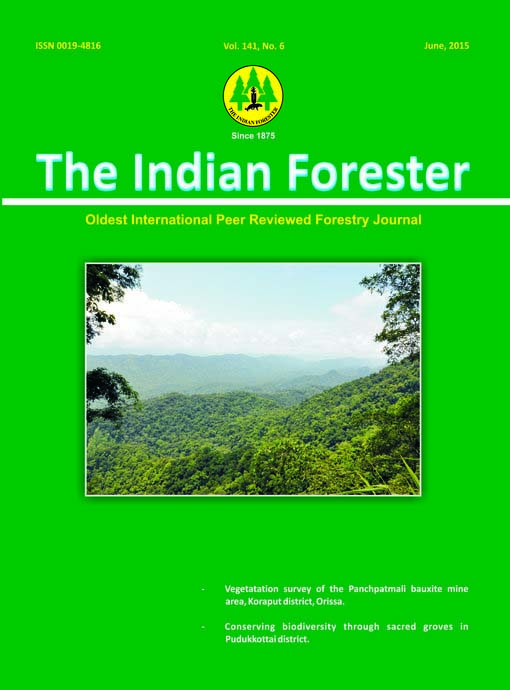Occurrence, Damage, Colour Morphism and Natural Enemies of Monolepta longitarsus Jacoby (Coleoptera: Chrysomellidae), a Defoliating Pest of Cashew
DOI:
https://doi.org/10.36808/if/2015/v141i6/71329Keywords:
Chrysomelid Beetle, Cashew, Shoot Damage, Pruning, Colour Morphism.Abstract
The present study aimed at investigating the occurrence, damage pattern and natural enemies of a chrysomelid beetle Monolepta longitarsus Jacoby (Chrysomelidae: Coleoptera). Occurrence of the beetle was noticed in cashew plantations at Puttur and Shantigodu, Dakshina Kannada of Karnataka, India during 2012 and 2013. These beetles appeared immediately in large numbers after south-west monsoon showers (June) and infestation was continued on cashew, up to August. Dispersal of this pest did not follow a consistent pattern. Beetles in groups of 60-75 were capable of causing complete drying of cashew shoots within 2-3 days and thus the damage spread was fast. Four different colour morphs of beetles were noticed, in which, reddish orange colour morphs were dominant (> 60 %) throughout the observation period followed by black shouldered red and random mating was observed between all four colour morphs. A few species of reduviids and praying mantises were recorded as predators and Beauveria bassiana as entomopathogenic fungus of these beetles.References
AICRP-C. (2012). All India Coordinated Research Project on Cashew, Annual report 2012-13. Puttur, Dakshina Kannada, Karnataka, India. Published by DCR.81-82p.
DCR, (2014). Cashew News. Half yearly newsletter of Directorate of Cashew Research, Puttur. January-June 2014. 19 (1):1
Fay H.A.C., Storey R.I., Defaveri S.G. and Brown J.D. (1993). Suppression of reproductive development and longevity in the red shouldered leaf beetle, Monolepta australis (Col.: Chrysomelidae) by the tachinid, Monoleptophaga caldwelli (Dipt.). Entomophaga, 38 (3): 335-342
Honek A., Martinkova Z., Saska P. and Dixon A.F.G. (2012). Temporal variation in elytral colour polymorphism in Hippodamia variegate (Coleoptera: Coccinellidae). European Journal of Entomology, 109: 389–394.
Lus J.J. (1928). On the inheritance of colour and pattern in lady beetles Adalia bipunctata L. and Adalia decempunctata L. Izv Byuro Genet Leningrad, 6: 89-163.
Lus J.J. (1932). An analysis of the dominance phenomenon in the inheritance of the elytra and pronotum colour in Adalia bipunctata. Trudy Lab Genet, 9: 135-162.
Mariamma Daniel. (2009). Pest and Disease management in cocoa plantations. The Cashew and Cocoa Journal, 1 (1): 18-23.
Neal M. (1993). The insects of Australia- A text book for students and Research Workers sponsored by The Division of Entomology Commonwealth Scientific and Industrial research Organization Australia- Melbourne University Press.Agnote 565p. No.12.
NRCC. (1983). National Research Centre for Cashew, Annual report. 1983. Puttur, Dakshina Kannada, Karnataka. India. 23p.
NRCC. (1988). National Research Centre for Cashew, Annual Report 1987-88. Puttur, Dakshina Kannada, Karnataka, India.
Osawa N. and Nishida T. (1992). Seasonal variation in elytral colour polymorphism in Harmonia axyridis (the ladybird beetle): the role of non-random mating. Heredity, 12: 297–307.
Pathummal Beevi S., Jagadeesh kumar T.N., Suma A., Usha K.E. and George Mathew. (1993). New record of Anigraea albomaculata Hamp. (Noctuidae: Lepidoptera) as a pest of cashew in Kerala. The Cashew, 7 (3): 14-16.
Rai P.S. (1980). Monolepta longitarsus Jac. (Chrysomelidae: Coleoptera): a leaf feeding pest of tapioca. In: National Seminar on Tuber Crops Production Technology, Nov. 1980, Tamil Nadu Agric. Univ. (India). pp.89.
Rai, P.S. (1984). In: Hand book of cashew pests. (N.K. Sharma Ed.) Researchco Publications, New Delhi. 17-18p.124 p.
Stapel H., Misof B., and Wagner T. (2008). A molecular and morphological phylogenetic analysis of Afrotropical Monolepta species and related Galerucinae (Coleoptera: Chrysomelidae). Arthropod Systematics and Phylogeny, 66 (1): 3-17.
Sundararaju D., Raviprasad T.N., and Shivarama Bhat P. (1999). Pests of cashew and their integrated management. In: IPM system in Agriculture. (Rajeev .K, Upathyay, K.G., Mukerji, O.P. Dubey eds). Aditya Books Pvt Ltd. New Delhi, India. Vol. 6. Cash crops. Pp. 525544.
Yu G.Y. (2008). Ladybird, Ladybird. Chemical Industry Press, 28pp.
Downloads
Downloads
Published
How to Cite
Issue
Section
License
Unless otherwise stated, copyright or similar rights in all materials presented on the site, including graphical images, are owned by Indian Forester.





